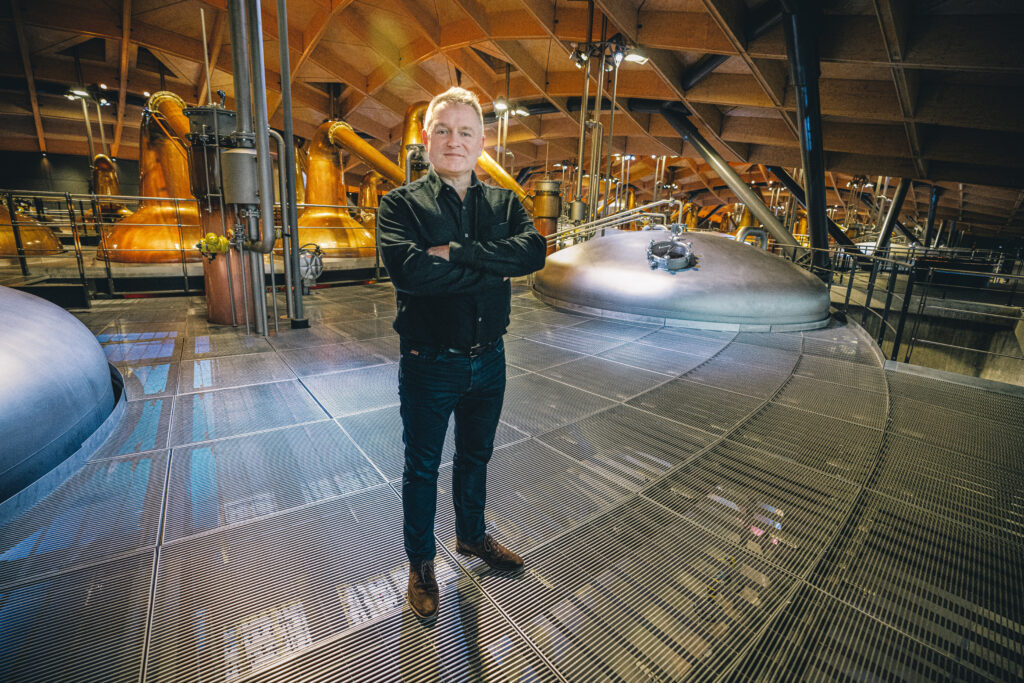
A deep and rich history is at the heart of the whisky world – one of Scotland’s foremost industries and exports – and nowhere more so than in one of the very first distilling regions of the country. The Cabrach region is steeped in beauty and whisky tales and is now being lovingly regenerated by The Cabrach Trust. To tell us more about the history and share the passion for his new role as the Non-executive Chair of the Cabrach Distillery, we were delighted to talk to Glen Gribbon, who is also Marketing Director of The Macallan.
As the first inaugural Non-executive Chair of the Cabrach Distillery, can you tell us about your ambitions for the role and the vision overall?
The Cabrach Trust was established in 2011 to preserve the cultural heritage of the Cabrach region – a remote community and area within Speyside. The distillery itself is one of the key projects which the Trust is taking forward to provide economic and social development for the area, creating jobs and attracting more visitors.
The building of the Cabrach Distillery has begun and it is expected to complete in late 2023. It will be operated as a social enterprise, which was of significant importance to me taking on this role. All profits will be reinvested in projects that will help to build resilience and long-term sustainability in The Cabrach. The distillery and heritage centre will provide a sustainable income for the activities of the Trust and will serve as an important social hub for a remote dispersed community. It is essentially the regeneration of an area through its whisky history; that provides a great purpose to the business.
The model in many ways reflects that of the relationship the Edrington Group has with the Robertson Trust – our biggest shareholder – and the way they reinvest their dividends in very important regeneration and community projects across Scotland.
In terms of our vision it is paramount, and I say this unapologetically, that it must be commercially successful. If it doesn’t generate profit we won’t be able to reinvest back into the community to make other projects viable.
In addition to the building of the Cabrach Distillery there is also an opportunity to put the area back on the map with a new whisky brand. This is not a big distillery, it will produce 100,000 litres of whisky a year. Compared to the Macallan distillery which produces 11 million litres of whisky per year it is very small. As a brand overall it has so much to offer: the regeneration of an area; a genuine community connection and ambition; a new distillery business; and, of course, a new whisky. I am very excited about the whole project and delighted to be part of it.
“This isn’t just about whisky – it is also about creating jobs and encouraging people to come and live in the area.”
What makes the Cabrach region so important culturally and historically?
In the early 1800s before whisky distilleries really were established and made legal farmers in the Cabrach region were the most renowned illicit whisky distillers in Scotland. It was the Excise act of 1823 which outlawed small-scale illicit whisky making and allowed big scale distilleries to open and take over. Without the Cabrach area and that early illicit distilling in the area of Speyside, which is now the prime area of whisky production in Scotland, there was a real danger that this place could have been forgotten.
There is an incredible whisky heritage and authenticity connected with the area and you are still able to walk around today and find some of those small distilleries that were attached to farms. There is a lovely idea of the distillery bringing whisky production back to the area and regenerating it, bringing it full circle.
The area itself is not too far outside Dufftown in Moray, but when you arrive at it you really do feel it is incredibly remote. It sits at the heart of the Speyside whisky country and that was what really captured my imagination initially.
One of our Non-Execs on the distillery Board is Alan Winchester and he was a master distiller for the Glenlivet. Alan really does bring the whole project to life, and there are other great whisky names attached to the project which enhances the pedigree and relevance of this project to the whole history and heritage.
Considered the birthplace of malt whisky – how is the team at the Cabrach Trust and Distillery working to regenerate the area and create a sustainable approach for the future with this history in mind?
This isn’t just about whisky – it is also about creating jobs and encouraging people to come and live in the area, that is very much part of the agenda, ensuring more people and families want to consider this as a place to call home.
Whilst the region is central to whisky history it wasn’t just impacted by the decline of whisky making, the First World War severely impacted the region to the point that it was a material factor in population decline in the area. This is featured centrally in the heritage centre being built next to the distillery and we want to tell not just of whisky but also about the area and the community, past and present, and the natural beauty, resources and entrepreneurial approach.
The area has some amazing walking trails and woodland paths which are being enhanced by the Trust, and the well-known Grouse Inn sits within the Cabrach. The Cabrach Trust is working hard to put together the right scale of infrastructure needed to encourage individual and small group tourism back to the area.
The Cabrach area is also one of 30 locations in Scotland designated a ‘dark sky discovery site’ which means that people can come and see incredibly clear dark skies which are only visible in very few parts of the country. That is a great environmental story and is important that we retain that.
The distillery is clearly one of the most important investments and biggest project but there are lots of other activities ongoing.
In your executive life as Marketing Director for The Macallan, can you tell us more about the importance of place and community for the industry across Scotland?
We have seven building blocks which make up the The Macallan DNA and these frame all of our content and approach. Community is a core building block them and applies centrally to the brand today and specifically how we think about Speyside area where our Distillery and The Macallan Estate is based.
Community support has been central to the history of The Macallan and if you go back into the history of the brand you see great examples of owners and pioneers contributing to the history, regeneration and development of the local communities. For example, James Stewart who was one of the distillery owners between 1860-1892, donated a very large part of the Estate to building Aberdeen General Hospital and Gray’s Hospital in Elgin.
The Macallan today is the biggest whisky brand in the Edrington Group which allows The Robertson Trust to do incredible work across Scotland. Anyone that works for Edrington and Macallan is really proud of the work that the Robertson Trust does and the relationship that our business has to support that.
The distillery is now one of the biggest employers in the Speyside area and we also bring a particular consumer to the area, which is reflective of the brand’s appeal.
At the local level we have a list of initiatives but one of my favourites is with the Archiestown village, which is the closest neighbour to the Macallan Distillery. We have contributed about £6k to civic spaces in the village and our Edrington team has used some of its ‘Giving More Days’ to maintenance and other projects reflecting our community responsibility in the area. That support for community does extend beyond Scotland and into all the local markets where we operate around the world and the sense of charitable giving resonates right across the Edrington brand. It is important being part of the organisation to feel genuinely committed to that charitable approach and to get involved.
How are you building a sustainability approach into the work that you do with Edrington group?
There is an Edrington Group strategy and a Macallan specific strategy relating to sustainability and every decision we make is taken in the context of those strategies.
Within the Macallan team we have three pillars: Net Zero; Climate Impact and Society. Our Net Zero ambitions align with the Edrington Group commitment to be Net Zero by 2045. The Macallan Distillery is new and we were able to factor that target into our build. It is essentially a green distillery with 85 per cent of our heat requirements coming from biomass and we are aiming to get that up to 90 per cent soon.
Beyond the distillery we have a whole range of initiatives, but particularly our approach to enhancing biodiversity in and around the Distillery and Macallan Estate, including the Cairngorms National Park. We also invest in the enhancement of wild salmon conservation in the area, which is really important for us as the Estate boundaries the River Spey.
